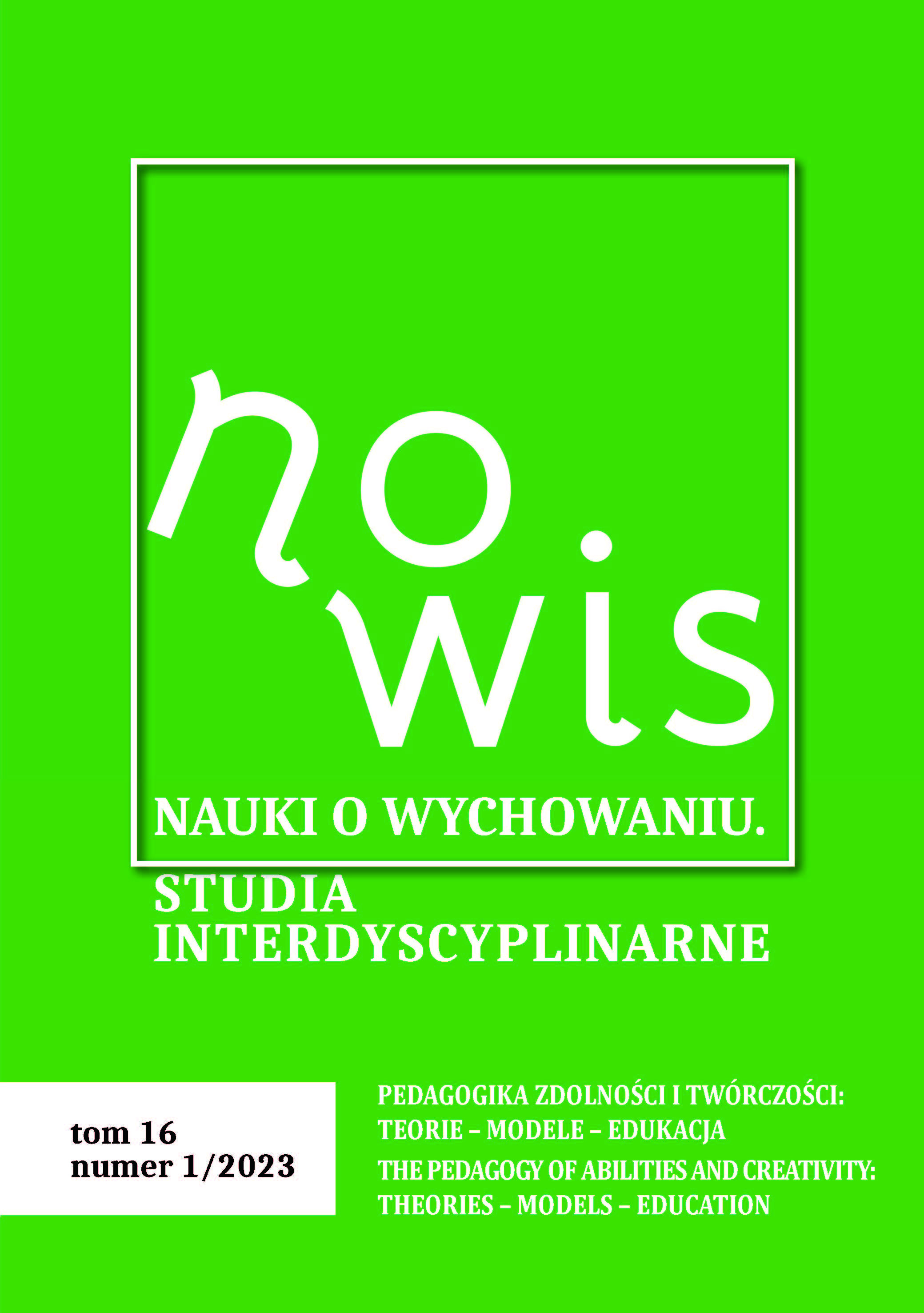Escaping Beyond the Shadow Thrown by the Limits of Body and Mind – Savant Syndrome in Filmmakers’ Optics
DOI:
https://doi.org/10.18778/2450-4491.16.17Keywords:
savant syndrome, special abilities, film biographyAbstract
The main aim of this article is to present two stories of savant figures who have been, on the one hand, significant personalities in the world of science and, on the other hand, have struggled with neurodevelopmental disorders and schizophrenia. These figures are Temple Grandin and John Nash. Their stories have also inspired the filmmakers of two films which have already become part of the cinematic canon and won multiple accolades, including awards for the main actors who created brilliant portraits of the neurodivergent geniuses. The hermeneutical analysis of these motion pictures is aimed at showing the specific ways in which the prodigious savants function, with particular focus on the role played by the closest social environment in creating conditions beneficial for the development of their special talents.
References
Andreasen N. A. (2015) John and Alice Nash: A Beautiful Love Story, „The American Journal of Psychiatry”, nr 8(172), s. 710–713, https://doi.org/10.1176/appi.ajp.2015.15060709
Google Scholar
DOI: https://doi.org/10.1176/appi.ajp.2015.15060709
Barks C. (2016) Rumi’s Little Books of Love and Laughter: Teaching Stories and Fables, Newburyport, MA, Hampton Roads Publishing.
Google Scholar
Chi R. P., Snyder A. W. (2011) Facilitate Insight by Non-Invasive Brain Stimulation, „PLoS ONE”, nr 6(2), s. 1–7, https://doi.org//10.1371/journal.pone.0016655
Google Scholar
DOI: https://doi.org/10.1371/journal.pone.0016655
Clare C. (2017) Lord of Shadows, New York, Simon and Schuster.
Google Scholar
Eastwood S., Evans B., Gaigg S., Harbord J., Milton D. (2022) Autism Through Cinema: Co-Creation and the Unmaking of Knowledge, „International Journal of Qualitative Studies in Education”, Ahead of Print, https://doi.org/10.1080/09518398.2022.2025492
Google Scholar
DOI: https://doi.org/10.1080/09518398.2022.2025492
Garret M., Ezzo M. (1996) Edutainment. The Challenge, „Journal of Interactive Instruction Development”, nr 3(8), s. 3–7.
Google Scholar
Grandin T. (1995) Thinking in Pictures. My Life with Autism, New York, Doubleday, Bantam Doubleday Dell Publishing.
Google Scholar
Grandin T., Duffy Kate (2004) Developing Talents: Careers for Individuals with Asperger Syndrome and Highfunctioning, Minnetonka, Autism Asperger Publishing Company.
Google Scholar
Grandin T., Johnson C. (2005) Animals in Translation: Using the Mysteries of Autism to Decode Animal Behavior, London, Bloomsbury Publishing.
Google Scholar
Gyarmathy É. (2018) The Savant Syndrome and Its Connection to Talent Development, „Open Science Journal of Psychology”, nr 2(5), s. 9–16.
Google Scholar
Hughes J. E. A., Ward J., Gruffydd E., Baron-Cohen S., Smith P., Allison C., Simner J. (2018) Savant Syndrome Has a Distinct Psychological Profile in Autism, „Molecular Autism”, nr 9, s. 53, https://doi.org/10.1186/s13229-018-0237-1
Google Scholar
DOI: https://doi.org/10.1186/s13229-018-0237-1
Kéri S. (2009) Genes for Psychosis and Creativity: A Promoter Polymorphism of the Neuregulin 1 Gene Is Related to Creativity in People With High Intellectual Achievement, „Psychological Science”, nr 20(9), s. 1070–1073, https://doi.org/10.1111/j.1467-9280.2009.02398.x
Google Scholar
DOI: https://doi.org/10.1111/j.1467-9280.2009.02398.x
Krasoń K. (2020) Padawanika. Przebudzenie mocy w doświadczeniu zapośredniczonym. Studium o filmie, wychowaniu i wsparciu rozwoju, Katowice, Wydawnictwo Uniwersytetu Śląskiego.
Google Scholar
Nasar S. (1998) A Beautiful Mind, New York, Simon & Schuster.
Google Scholar
Schipperheijn J. A. M., Dunne F. J. (1990) The Savant Syndrome Genius and Mental Handicap Combined, „Psychiatric Bulletin”, nr 14, s. 475–476, https://doi.org/10.1192/pb.14.8.475
Google Scholar
DOI: https://doi.org/10.1192/pb.14.8.475
Snyder A. W., Mulcahy E., Taylor J. L., Mitchell D. J., Sachdev P., Gandevia S. C. (2003) Savant- Like Skills Exposed in Normal People by Suppressing the Left Fronto-Temporal Lobe, „Journal of Integrative Neuroscience”, vol. 2, nr 2, s. 149–158, https://doi.org/10.1142/s0219635203000287
Google Scholar
DOI: https://doi.org/10.1142/S0219635203000287
Treffert D. A. (2009) The Savant Syndrome: An Extraordinary Condition. A Synopsis: Past, Present, Future, „Philosophical Transactions of The Royal Society B – Biological Sciences”, nr 1522(364), s. 1351–1357, https://doi.org/10.1098/rstb.2008.0326
Google Scholar
DOI: https://doi.org/10.1098/rstb.2008.0326
Treffert D. A. (2014) Savant Syndrome: Realities, Myths and Misconceptions, „Journal of Autism and Developmental Disorders”, nr 44, s. 564–571, https://doi.org/10.1007/s10803-013-1906-8
Google Scholar
DOI: https://doi.org/10.1007/s10803-013-1906-8
Wojtyniak J. (2015) Edutainment i edukacja filmowa jako narzędzia kształtowania tożsamości oraz postaw dzieci i młodzieży, „Państwo i Społeczeństwo”, nr 1, s. 170.
Google Scholar
DeGroot D. (2020) Dr. Temple Grandin of CSU Named One of the Top College Professors in the Country, [online:] https://ourcommunitynow.com/news-local/dr-temple-grandin-of-csu-named-one-of-the-top-college-professors-in-the-country (dostęp: 1.11.2022).
Google Scholar
Grandin T. (2014) Temple Grandin Askwith Forum: All Kinds of Minds Help the World, [online:] https://www.youtube.com/watch?v=9klKhlc_cJg (dostęp: 30.10.2022).
Google Scholar
Grandin T. (2016) Educating Students Who Have Different Kinds of Minds, [online:] https://www.youtube.com/watch?v=8LCrjUL8qU4&t=629s (dostęp: 30.10.2022).
Google Scholar
John F. Nash Jr. – Facts, [online:] https://www.nobelprize.org/prizes/economic-sciences/1994/nash/facts/ (dostęp: 30.10.2022).
Google Scholar
Leonard T. (2010) Temple Grandin: My Autism Made Me A Cowgirl Superstar, [online:] https://www.beefmagazine.com/people/0929-temple-grandin-cowgirl-superstar (dostęp: 1.11.2022).
Google Scholar
Meet Kim Peek: The incredible case of the man who could memorize everything (2022/2023), [online:] https://yestherapyhelps.com/meet-kim-peek-the-incredible-case-of-the-man-who-could-memorize-everything-10280 (dostęp: 31.10.2022).
Google Scholar
Nutt A. E. (2015) Alicia Nash, wife of Nobel Laureate, dies at 82, „The Washington Post”, may 27, [online:] https://www.washingtonpost.com/national/health-science/alicia-nash-wife-of-nobel-laureate-dies-at-82/2015/05/27/6fced406-0479-11e5-bc72-f3e16bf50bb6_story.html (dostęp: 31.11.2022).
Google Scholar
Spektrum autyzmu w filmowej opowieści – wywiad z organizatorami Przeglądu Filmów o Autyzmie i Zespole Aspergera (2019) [online:] https://www.wszpwn.com.pl/wydarzenie/spektrum-autyzmu-w-filmowej-opowiesci-wywiad-z-organizatorami-przegladu-filmow-o-autyzmie-i-zespole-aspergera,459.htSpektrum%20autyzmu%20w%20filmowej%20opowie%C5%9Bci%20-%20wywiad%20z%20organizatorami%20Przegl%C4%85du%20Film%C3%B3w%20o%20Autyzmie%20i%20Zespole%20Aspergera (dostęp: 15.10.2022).
Google Scholar
Temple Grandin, Ph.D., [online:] https://www.templegrandin.com/ (dostęp: 1.10.2022).
Google Scholar
: A Space Odyssey (1968) reż. Stanley Kubrick, Metro-Goldwyn-Mayer, USA – Wielka Brytania.
Google Scholar
A Beautiful Mind (2001) reż. Ron Howard, DreamWorks SKG – Imagine Entertainment – Universal Pictures, USA.
Google Scholar
Extra Life: A Short History of Living Longer (2021) serial dokumentalny, Wielka Brytania – USA, sezon 1, odcinek 3.
Google Scholar
Rain Man (1988) reż. Barry Levinson, United Artist – Guber-Peters Company, USA.
Google Scholar
Temple Grandin (2010) reż. Mick Jackson, HBO Films – Ruby Films, USA.
Google Scholar






 The journal's website, created and edited by the NOWiS Editorial Team on the Index Copernicus platform:
The journal's website, created and edited by the NOWiS Editorial Team on the Index Copernicus platform: 





